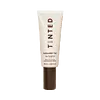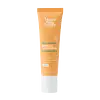Live Tinted Hueguard Skin Tint SPF 50 Mineral Sunscreen Broad Spectrum Versus Thrive Causemetics Daily Defender Mineral Sunscreen Broad Spectrum SPF 50
What's inside
What's inside
 Key Ingredients
Key Ingredients

 Benefits
Benefits

 Concerns
Concerns

 Ingredients Side-by-side
Ingredients Side-by-side

Zinc Oxide 95%
Cosmetic ColorantAllantoin
Skin ConditioningAluminum Hydroxide
EmollientAscorbyl Palmitate
AntioxidantBisabolol
MaskingBuddleja Davidii Callus Extract
Butyloctyl Salicylate
Skin ConditioningC12-15 Alkyl Benzoate
AntimicrobialC13-15 Alkane
SolventCaprylic/Capric Triglyceride
MaskingCaprylyl Glycol
EmollientCitric Acid
BufferingCoco-Caprylate
EmollientCrocus Sativus Flower Extract
MaskingDisteardimonium Hectorite
StabilisingGlycerin
HumectantHippophae Rhamnoides Seed Oil
Skin ProtectingHydrogenated Lecithin
EmulsifyingHydrolyzed Sodium Hyaluronate
Skin ConditioningIron Oxides
Isoamyl Laurate
EmollientLecithin
EmollientMethylpropanediol
SolventPhenylpropanol
MaskingPhysalis Pubescens Fruit Juice
Skin ConditioningPolyglyceryl-3 Polyricinoleate
EmulsifyingPolyglyceryl-4 Diisostearate/Polyhydroxystearate/Sebacate
EmulsifyingPyrus Malus Fruit Extract
Skin ConditioningSilica
AbrasiveSilica Silylate
EmollientSodium Chloride
MaskingSodium Hyaluronate
HumectantCI 77891
Cosmetic ColorantTocopherol
AntioxidantWater
Skin ConditioningWithania Somnifera Root Extract
Skin ConditioningXanthan Gum
EmulsifyingZinc Oxide 95%, Allantoin, Aluminum Hydroxide, Ascorbyl Palmitate, Bisabolol, Buddleja Davidii Callus Extract, Butyloctyl Salicylate, C12-15 Alkyl Benzoate, C13-15 Alkane, Caprylic/Capric Triglyceride, Caprylyl Glycol, Citric Acid, Coco-Caprylate, Crocus Sativus Flower Extract, Disteardimonium Hectorite, Glycerin, Hippophae Rhamnoides Seed Oil, Hydrogenated Lecithin, Hydrolyzed Sodium Hyaluronate, Iron Oxides, Isoamyl Laurate, Lecithin, Methylpropanediol, Phenylpropanol, Physalis Pubescens Fruit Juice, Polyglyceryl-3 Polyricinoleate, Polyglyceryl-4 Diisostearate/Polyhydroxystearate/Sebacate, Pyrus Malus Fruit Extract, Silica, Silica Silylate, Sodium Chloride, Sodium Hyaluronate, CI 77891, Tocopherol, Water, Withania Somnifera Root Extract, Xanthan Gum
Zinc Oxide 19%
Cosmetic ColorantWater
Skin ConditioningCaprylic/Capric Triglyceride
MaskingDiisooctyl Succinate
EmollientPropanediol
SolventButyloctyl Salicylate
Skin ConditioningDicaprylyl Carbonate
EmollientNiacinamide
SmoothingGlycerin
HumectantEthylhexyl Methoxycrylene
Skin ConditioningPolymethylsilsesquioxane
Cetearyl Olivate
Magnesium Aluminum Silicate
AbsorbentPolyhydroxystearic Acid
EmulsifyingTerminalia Ferdinandiana Fruit Extract
AntioxidantVaccinium Vitis-Idaea Fruit Extract
AntioxidantPongamia Pinnata Seed Extract
Skin ConditioningMaleated Soybean Oil Glyceryl/Octyldodecanol Esters
Ectoin
Skin ConditioningAloe Barbadensis Leaf Juice
Skin ConditioningSodium Hyaluronate
HumectantAscorbyl Tetraisopalmitate
AntioxidantMenthyl Lactate
MaskingJojoba Esters
EmollientTriethoxycaprylylsilane
Arachidyl Alcohol
EmollientSilica
AbrasiveLauroyl Lysine
Skin ConditioningPotassium Cetyl Phosphate
EmulsifyingPolyglyceryl-4 Laurate/Succinate
Hydroxyethyl Acrylate/Sodium Acryloyldimethyl Taurate Copolymer
Emulsion StabilisingIsononyl Isononanoate
EmollientOctyldodecanol
EmollientEthylene/Propylene/Styrene Copolymer
Polyglutamic Acid
Skin ConditioningSorbitan Oleate
EmulsifyingTrihydroxystearin
Skin ConditioningArachidyl Glucoside
EmulsifyingSorbitan Olivate
EmulsifyingBehenyl Alcohol
EmollientXanthan Gum
EmulsifyingGluconolactone
Skin ConditioningCalcium Gluconate
HumectantTetrasodium Glutamate Diacetate
Citric Acid
BufferingSodium Benzoate
MaskingEthylhexylglycerin
Skin ConditioningCaprylyl Glycol
EmollientPhenoxyethanol
PreservativeCI 77891
Cosmetic ColorantIron Oxides
Zinc Oxide 19%, Water, Caprylic/Capric Triglyceride, Diisooctyl Succinate, Propanediol, Butyloctyl Salicylate, Dicaprylyl Carbonate, Niacinamide, Glycerin, Ethylhexyl Methoxycrylene, Polymethylsilsesquioxane, Cetearyl Olivate, Magnesium Aluminum Silicate, Polyhydroxystearic Acid, Terminalia Ferdinandiana Fruit Extract, Vaccinium Vitis-Idaea Fruit Extract, Pongamia Pinnata Seed Extract, Maleated Soybean Oil Glyceryl/Octyldodecanol Esters, Ectoin, Aloe Barbadensis Leaf Juice, Sodium Hyaluronate, Ascorbyl Tetraisopalmitate, Menthyl Lactate, Jojoba Esters, Triethoxycaprylylsilane, Arachidyl Alcohol, Silica, Lauroyl Lysine, Potassium Cetyl Phosphate, Polyglyceryl-4 Laurate/Succinate, Hydroxyethyl Acrylate/Sodium Acryloyldimethyl Taurate Copolymer, Isononyl Isononanoate, Octyldodecanol, Ethylene/Propylene/Styrene Copolymer, Polyglutamic Acid, Sorbitan Oleate, Trihydroxystearin, Arachidyl Glucoside, Sorbitan Olivate, Behenyl Alcohol, Xanthan Gum, Gluconolactone, Calcium Gluconate, Tetrasodium Glutamate Diacetate, Citric Acid, Sodium Benzoate, Ethylhexylglycerin, Caprylyl Glycol, Phenoxyethanol, CI 77891, Iron Oxides
Ingredients Explained
These ingredients are found in both products.
Ingredients higher up in an ingredient list are typically present in a larger amount.
Butyloctyl Salicylate is a chemical UV filter structurally similar to octisalate. It is a photostabilizer, SPF booster, emollient and solvent. This ingredient helps evenly spread out ingredients.
According to a manufacturer, it is suitable for pairing with micro Titanium Dioxide, Zinc Oxide, and pigments.
Photostabilizers help stabilize UV-filters and prevents them from degrading quickly.
Learn more about Butyloctyl SalicylateThis ingredient is an emollient, solvent, and texture enhancer. It is considered a skin-softener by helping the skin prevent moisture loss.
It helps thicken a product's formula and makes it easier to spread by dissolving clumping compounds.
Caprylic Triglyceride is made by combining glycerin with coconut oil, forming a clear liquid.
While there is an assumption Caprylic Triglyceride can clog pores due to it being derived from coconut oil, there is no research supporting this.
Learn more about Caprylic/Capric TriglycerideCaprylyl Glycol is a humectant and emollient, meaning it attracts and preserves moisture.
It is a common ingredient in many products, especially those designed to hydrate skin. The primary benefits are retaining moisture, skin softening, and promoting a healthy skin barrier.
Though Caprylyl Glycol is an alcohol derived from fatty acids, it is not the kind that can dry out skin.
This ingredient is also used as a preservative to extend the life of products. It has slight antimicrobial properties.
Learn more about Caprylyl GlycolCi 77891 is a white pigment from Titanium dioxide. It is naturally found in minerals such as rutile and ilmenite.
It's main function is to add a white color to cosmetics. It can also be mixed with other colors to create different shades.
Ci 77891 is commonly found in sunscreens due to its ability to block UV rays.
Learn more about CI 77891Citric Acid is an alpha hydroxy acid (AHA) naturally found in citrus fruits like oranges, lemons, and limes.
Like other AHAs, citric acid can exfoliate skin by breaking down the bonds that hold dead skin cells together. This helps reveal smoother and brighter skin underneath.
However, this exfoliating effect only happens at high concentrations (20%) which can be hard to find in cosmetic products.
Due to this, citric acid is usually included in small amounts as a pH adjuster. This helps keep products slightly more acidic and compatible with skin's natural pH.
In skincare formulas, citric acid can:
While it can provide some skin benefits, research shows lactic acid and glycolic acid are generally more effective and less irritating exfoliants.
Most citric acid used in skincare today is made by fermenting sugars (usually from molasses). This synthetic version is identical to the natural citrus form but easier to stabilize and use in formulations.
Read more about some other popular AHA's here:
Learn more about Citric AcidGlycerin is already naturally found in your skin. It helps moisturize and protect your skin.
A study from 2016 found glycerin to be more effective as a humectant than AHAs and hyaluronic acid.
As a humectant, it helps the skin stay hydrated by pulling moisture to your skin. The low molecular weight of glycerin allows it to pull moisture into the deeper layers of your skin.
Hydrated skin improves your skin barrier; Your skin barrier helps protect against irritants and bacteria.
Glycerin has also been found to have antimicrobial and antiviral properties. Due to these properties, glycerin is often used in wound and burn treatments.
In cosmetics, glycerin is usually derived from plants such as soybean or palm. However, it can also be sourced from animals, such as tallow or animal fat.
This ingredient is organic, colorless, odorless, and non-toxic.
Glycerin is the name for this ingredient in American English. British English uses Glycerol/Glycerine.
Learn more about GlycerinSilica, also known as silicon dioxide, is a naturally occurring mineral. It is used as a fine, spherical, and porous powder in cosmetics.
Though it has exfoliant properties, the function of silica varies depending on the product.
The unique structure of silica enhances the spreadability and adds smoothness, making it a great texture enhancer.
It is also used as an active carrier, emulsifier, and mattifier due to its ability to absorb excess oil.
In some products, tiny microneedles called spicules are made from silica or hydrolyzed sponge. When you rub them in, they lightly polish away dead skin layers and enhance the penetration of active ingredients.
Learn more about SilicaSodium Hyaluronate is hyaluronic acid's salt form. It is commonly derived from the sodium salt of hyaluronic acid.
Like hyaluronic acid, it is great at holding water and acts as a humectant. This makes it a great skin hydrating ingredient.
Sodium Hyaluronate is naturally occurring in our bodies and is mostly found in eye fluid and joints.
These are some other common types of Hyaluronic Acid:
Learn more about Sodium HyaluronateWater. It's the most common cosmetic ingredient of all. You'll usually see it at the top of ingredient lists, meaning that it makes up the largest part of the product.
So why is it so popular? Water most often acts as a solvent - this means that it helps dissolve other ingredients into the formulation.
You'll also recognize water as that liquid we all need to stay alive. If you see this, drink a glass of water. Stay hydrated!
Learn more about WaterXanthan gum is used as a stabilizer and thickener within cosmetic products. It helps give products a sticky, thick feeling - preventing them from being too runny.
On the technical side of things, xanthan gum is a polysaccharide - a combination consisting of multiple sugar molecules bonded together.
Xanthan gum is a pretty common and great ingredient. It is a natural, non-toxic, non-irritating ingredient that is also commonly used in food products.
Learn more about Xanthan GumZinc Oxide is a mineral broad-spectrum UV filter; it is the broadest UVA and UVB reflector approved by the FDA. It also has skin protectant and skin soothing properties.
Zinc oxide is one of the most effective broad-spectrum UV filters. It protects against UVB, UVAII, and UVAI. In comparison to its counterpart titanium dioxide, zinc oxide provides uniform and extended UVA protection.
Another great benefit? This ingredient is highly photostable so it won't degrade easily under sunlight.
A common myth is that mineral UV filters are widely believed to primarily reflect UV light.
However, modern research shows titanium dioxide absorbs UV radiation like chemical filters (~95% absorption & 5% reflection).
Zinc oxide has great skin soothing properties so you'll likely find this in sunscreens formulated for sensitive skin or babies/children. It is unlikely to cause "eye sting" like other sunscreen ingredients.
Regulatory agencies consider zinc oxide to be non-toxic and safe. It has also been shown to not penetrate the skin.
Unfortunately, this ingredient does leave a visible white cast. This is why mineral sunscreens are often less cosmetically elegant than chemical or hybrid ones.
In cosmetics, zinc oxide can be found in both non-nano and nano-sized forms. The nano version is used to reduce white cast and improve the texture of sunscreen formulas.
There are ongoing concerns surrounding nano-zinc oxide's impact on marine ecosystems and whether it can be absorbed into skin.
Regarding marine ecosystems and coral reefs, there is no conclusive evidence that any form of zinc oxide (or any other sunscreen ingredients) will cause harm. The science is still developing but many consumers are keeping a close eye on this issue.
Please note, many destinations have reef-safety sunscreen rules. For instance, the U.S. Virgin Islands advises all visitors to use non-nano mineral sunscreens.
There has also been some stir about whether micronized or nano zinc oxide has potential photoxicity and absorption through the skin/lungs.
An in-vitro (done in a test tube or petri dish) study demonstrated micronized zinc oxide to have potential phototoxicity. There's no need to fret; the EU Commission's Scientific Committee on Consumer Safety has stated, "The relevance of these findings needs to be clarified by appropriate investigations in vivo." Or in other words, further studies done on living organisms are needed to prove this.
Current research shows zinc oxide nanoparticles do not penetrate intact or sunburned skin. They either remain on the surface or in the outermost layer of dead skin (stratum corneum).
Zinc oxide is one of only two classified mineral UV filters with titanium dioxide being the other one.
Fun fact: Zinc has been used throughout history as an ingredient in paint and medicine. An Indian text from 500BC is believed to list zinc oxide as a salve for open wound. The Ancient Greek physician Dioscorides has also mentioned the use of zinc as an ointment in 1AD.
Learn more about Zinc OxideThis ingredient is a combination of red, black, and yellow iron oxide pigments. This combination of colors is usually found in foundation, because it results in a "skin" color.